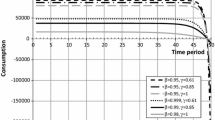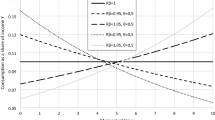Abstract
Intertemporal choice involves outcomes that are received in different moments of time. This paper presents a new framework for analyzing intertemporal choice as a tradeoff between the cumulative payoff of a stream of intertemporal outcomes and its average delay (similar to the mean–variance approach in modelling risk preferences). Ceteris paribus, a decision maker prefers a stream of intertemporal payoffs with a higher cumulative payoff and a lower average delay. A decision maker with such time preferences always dislikes a partial delay in consumption (splitting one payoff into two, one of which is slightly delayed in time). In contrast, many existing models (e.g. discounted utility, quasi-hyperbolic discounting, generalized hyperbolic discounting or liminal discounting) imply a preference for partial delay. Our proposed model is compatible with the common difference effect (corresponding to a horizontal fanning-out of indifference curves) and the absolute magnitude effect (corresponding to a vertical fanning-in of indifference curves). The proposed model is applied to the standard consumption-savings problem with a constant interest rate. A simple experimental test of the proposed model vs. discounted utility and quasi-hyperbolic discounting is presented.






Similar content being viewed by others
Notes
Similarly, Blavatskyy (2018) shows that when one payoff is split into two payoffs, one of which is payed slightly sooner, a decision maker with an additively-separable utility (e.g. discounted utility, quasihyperbolic discounting, generalized hyperbolic discounting or liminal discounting) and a convex utility function prefers the delayed unsplit payment.
Baucells and Sarin (2007a) consider a similar example with streams A and B.
If N subjects choose 50%-50% between the first and the second streams, then an experimenter observes N/4 subjects consistently choosing the first stream; N/4 subjects consistently choosing the second stream; and N/2 subjects switching between the first and the second stream. The highest number N that is consistent with choice frequencies observed in the experiment is thus the highest N such that N/4 ≤ 28, N/4 ≤ 23 and N/2 ≤ 49; or N = 92.
Gigliotti and Sopher (1997) also find that many subjects reveal a preference for a constant stream over increasing and decreasing streams.
References
Abdellaoui, M., Gutierrez, C., & Kemel, E. (2018). Temporal discounting of gains and losses of time: An experimental investigation. Journal of Risk and Uncertainty, 57, 1–28.
Andreoni, J., Gravert, C., Kuhn, M.A., Saccardo, S., & Yang, Y. (2018). Arbitrage or narrow bracketing? On using money to measure intertemporal preferences. Working Paper 25232, National Bureau of Economic Research.
Andreoni, J., Kuhn, M. A., & Sprenger, C. (2015). Measuring time preferences: A comparison of experimental methods. Journal of Economic Behavior and Organization, 116, 451–464.
Andreoni, J., & Sprenger, C. (2015). Risk preferences are not time preferences: Reply. American Economic Review, 105, 2287–2293.
Andreoni, J., & Sprenger, C. (2012). Estimating time preferences from convex budgets. American Economic Review, 102, 3333–3356.
Attema, A. E., Bleichrodt, H., L’Haridon, O., Peretti-Watel, P., & Seror, V. (2018). Discounting health and money: New evidence using a more robust method. Journal of Risk and Uncertainty, 56, 117–140.
Baucells, M., & Sarin, R. K. (2007a). Evaluating time streams of income: Discounting what? Theory and Decision, 63, 95–120.
Baucells, M., & Sarin, R. K. (2007b). Satiation in discounted utility. Operations Research, 55(1), 170–181.
Blavatskyy, P. (2018). Temporal dominance and relative patience in intertemporal choice. Economic Theory, 65(2), 361–384.
Blavatskyy, P. (2016). A monotone model of intertemporal choice. Economic Theory, 62(4), 785–812.
Blavatskyy, P. (2015). Intertemporal choice with different short-term and long-term discount factors. Journal of Mathematical Economics, 61, 139–143.
Blavatskyy, P., & Maafi, H. (2018). Estimating representations of time preferences and models of probabilistic intertemporal choice on experimental data. Journal of Risk and Uncertainty, 56(3), 259–287.
Bradford, D. W., Dolan, P., & Galizzi, M. M. (2019). Looking ahead: Subjective time perception and individual discounting. Journal of Risk and Uncertainty, 58, 43–69.
Cheung, S. (2019). Eliciting utility curvature in time preference. Experimental Economics, forthcoming.
Freeman, G. H., & Halton, J. H. (1951). Note on exact treatment of contingency, goodness of fit and other problems of significance. Biometrika, 38, 141–149.
Gigliotti, G., & Sopher, B. (1997). Violations of present-value maximization in income choice. Theory and Decision, 43, 45–69.
Holcomb, J. H., & Nelson, P. S. (1992). Another experimental look at individual time preference. Rationality and Society, 4(2), 199–220.
Koopmans, T. (1960). Stationary ordinal utility and impatience. Econometrica, 28, 287–309.
Loewenstein, G. (1988). Frames of mind in intertemporal choice. Management Science, 34, 200–214.
Loewenstein, G., & Prelec, D. (1991). Negative time preference. American Economic Review Papers and Proceedings, 81(2), 347–352.
Loewenstein, G., & Prelec, D. (1992). Anomalies in intertemporal choice: Evidence and an interpretation. Quarterly Journal of Economics, 107, 573–597.
Loewenstein, G., & Sicherman, N. (1991). Do workers prefer increasing wage profiles? Journal of Labour Economics, 9, 67–84.
Manzini, P., Mariotti, M., & Mittone, L. (2010). Choosing monetary sequences: Theory and experimental evidence. Theory and Decision, 69, 327–354.
Markowitz, H. (1952). Portfolio selection. Journal of Finance, 7(1), 77–91.
Phelps, E., & Pollak, R. (1968). On second-best national saving and game-equilibrium growth. The Review of Economic Studies, 35, 185–199.
Pan, J., Webb, C. S., & Zank, H. (2015). An extension of quasi-hyperbolic discounting to continuous time. Games and Economic Behavior, 89, 43–55.
Read, D., & Scholten, M. (2012). Tradeoffs between sequences: Weighing accumulated outcomes against outcome-adjusted delays. Journal of Experimental Psychology: Learning Memory and Cognition, 38(6), 1675–1688.
Read, D., & van Leeuwen, B. (1998). Predicting hunger: The effects of appetite and delay on choice. Organizational Behavior and Human Decision Processes, 76(2), 189–205.
Read, D., Loewenstein, G., & Kalyanaraman, S. (1999). Mixing virtue and vice: Combining the immediacy effect and the diversification heuristic. Journal of Behavioral Decision Making, 12(4), 257–273.
Rubinstein, A. (2003). Is it ‘Economics and Psychology’? The case of hyperbolic discounting. International Economic Review, 44, 1207–1216.
Rubinstein, A. (1988). Similarity and decision making under risk (Is there a utility theory resolution to the Allais Paradox?). Journal of Economic Theory, 46, 145–153.
Samuelson, P. (1937). A note on measurement of utility. The Review of Economic Studies, 4, 155–161.
Scholten, M., & Read, D. (2006). Discounting by intervals: A generalized model of intertemporal choice. Management Science, 52(9), 1424–1436.
Scholten, M., & Read, D. (2010). The psychology of intertemporal tradeoffs. Psychological Review, 117, 925–944.
Scholten, M., Read, D., & Sanborn, A. (2016). Cumulative weighing of time in intertemporal tradeoffs. Journal of Experimental Psychology: General, 145(9), 1177–1205.
Sayman, S., & Öncüler, A. (2009). An investigation of time inconsistency. Management Science, 55(3), 470–482.
Sprenger, C. (2015). Judging experimental evidence on dynamic inconsistency. American Economic Review: Papers and Proceedings, 105, 280–285.
Starmer, C. (2000). Developments in non-expected utility theory: The hunt for a descriptive theory of choice under risk. Journal of Economic Literature, 38, 332–382.
Thaler, R. H. (1981). Some empirical evidence on dynamic inconsistency. Economics Letters, 8, 201–207.
Varey, C., & Kahneman, D. (1990). Experiences extended across time: Evaluation of moments and episodes. Journal of Behavioral Decision Making, 5, 169–185.
Acknowledgements
I am grateful to the editor Kip Viscusi and the referee Daniel Read for very helpful comments. Pavlo Blavatskyy is a member of the Entrepreneurship and Innovation Chair, which is partof LabEx Entrepreneurship (University of Montpellier, France) and is funded by the French government (Labex Entreprendre, ANR-10-Labex-11-01).
Author information
Authors and Affiliations
Corresponding author
Additional information
Publisher's Note
Springer Nature remains neutral with regard to jurisdictional claims in published maps and institutional affiliations.
Appendix
Appendix
1.1 Experimental Instructions
Welcome to our experiment! This is an experiment in choice over time. It is financed from research funds. We would like to ask you to take six decisions in this experiment.
At the end of the experiment you will receive one or two discount coupons for a supermarket chain valid only on a specific day. Your payoff depends only on your decisions and the realization of random events. Your payoff does not depend on the decisions of other participants. Your anonymity will be preserved during and after the experiment.
During the experiment you need to answer six questions printed in your booklet. Please note that that there are no right or wrong answers in this experiment. Here is an example of a typical question that you may face during the experiment:
1.2 Question 1
Please choose your preferred alternative:

Please raise your hand when you answered all six questions. We will ask you to come forward with your booklet to our table. We then ask you to toss a die to randomly select one question number. This question will be used to determine your payoff.
For instance, suppose that the die comes up one. Then question 1 is selected. Suppose that question 1 in your booklet is the question shown above. If you have ticked the right alternative in this question, you receive one discount coupon worth €20 valid only on May 8th.
Please note that any question can be randomly selected at the end to determine your payoff. So it is in your best interest to answer all six questions carefully. Good luck!
Rights and permissions
About this article
Cite this article
Blavatskyy, P.R. Intertemporal choice as a tradeoff between cumulative payoff and average delay. J Risk Uncertain 64, 89–107 (2022). https://doi.org/10.1007/s11166-022-09370-3
Accepted:
Published:
Issue Date:
DOI: https://doi.org/10.1007/s11166-022-09370-3




